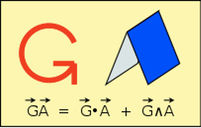Return to current section: Velocity Composition.
Exercise: Derive and interpret the relativistic velocity composition law: U′ = ṼU.
Therefrom, derive the corresponding composition laws for time dilations and relative velocities.
From the previous section on passive Lorentz transformations, the translation of coordinates of an event X from the unprimed inertial system to the primed system can be written as X′ = ṼX, where V is the proper velocity of the primed system with respect to the unprimed system. But that event may correspond to a moving particle. That particle has a history (a series of events observable by other systems) and a proper time parameterizing its history. We would take the derivative of its history with respect to its proper time to get its proper velocity U, whose coordinates can be calculated in any inertial system. Since V is a constant for these inertial systems, we can take the derivative of the last equation with respect to the particle's proper time to get U′ = ṼU.
As mentioned in deriving the Lorentz transformation in the previous section, because we are considering motion in one dimension (our x-axis), v∧u = v∧u' = 0, so simply multiply the terms and collect scalar and vector parts separately:
Similarly,
As a quick check on signs, if v/c is small, notice these formulas reduce to Galileo's velocity addition formula u = u' + v.
Return to current section: Velocity Composition.
